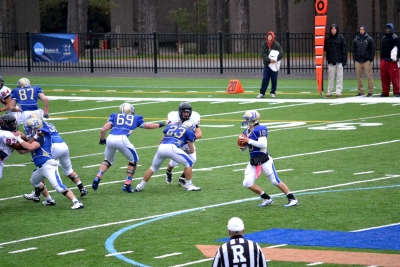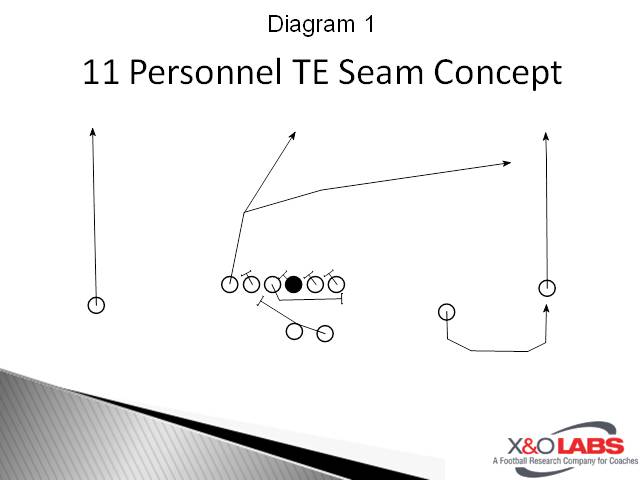By Ryan Anderson
Offensive Coordinator
Hamilton College
 Editor’s Note: Coach Anderson is entering his third year as the offensive coordinator for the Hamilton College football team. In 2012, the Continentals boasted their highest offensive output in 20 years with an average of more than 20 points per game. Two players made the NESCAC all-conference team on offense. James Stanell '14 led the conference in all-purpose yards per game last year and his 1,560 all-purpose yards are the second-highest total in NESCAC history. Stanell finished second in rushing yards per game and Joe Jensen '15 was third in receiving yards per game. Anderson was the offensive coordinator at Western New England University in 2010 and 2011. He helped guide the Golden Bears to the best record in team history at 10-2 in 2011. WNEU captured its first New England Football Conference (NEFC) championship and the Golden Bears made their first NCAA Division III championship appearance. The offense set numerous program records in Anderson's two years at WNEU, including total offense in a game (688 yards), total offense in a season (4,105 yards), points in a game (66) and points in a season (341). In 2010, the Golden Bears ranked second in the 16-team NEFC and 15th in Division III with 246.9 rushing yards per game. Anderson coached a total of nine NEFC Boyd Division all-division players on offense, including the 2010 NEFC Boyd Division Offensive Player of the Year.
Editor’s Note: Coach Anderson is entering his third year as the offensive coordinator for the Hamilton College football team. In 2012, the Continentals boasted their highest offensive output in 20 years with an average of more than 20 points per game. Two players made the NESCAC all-conference team on offense. James Stanell '14 led the conference in all-purpose yards per game last year and his 1,560 all-purpose yards are the second-highest total in NESCAC history. Stanell finished second in rushing yards per game and Joe Jensen '15 was third in receiving yards per game. Anderson was the offensive coordinator at Western New England University in 2010 and 2011. He helped guide the Golden Bears to the best record in team history at 10-2 in 2011. WNEU captured its first New England Football Conference (NEFC) championship and the Golden Bears made their first NCAA Division III championship appearance. The offense set numerous program records in Anderson's two years at WNEU, including total offense in a game (688 yards), total offense in a season (4,105 yards), points in a game (66) and points in a season (341). In 2010, the Golden Bears ranked second in the 16-team NEFC and 15th in Division III with 246.9 rushing yards per game. Anderson coached a total of nine NEFC Boyd Division all-division players on offense, including the 2010 NEFC Boyd Division Offensive Player of the Year.
We are a zone read team that incorporates a pitch phase in a lot of our run game. We feel that an effective play action pass game is important complement our base offense. We want to run the football effectively enough to influence secondary run support. This will give us good matchups to throw the football. We use the TE Seam concept to complement our base runs. We have had a lot of success with this play over the years. We primarily work out of the gun and use a TE (11 Personnel), 50% of the time. We also feel this great way to highlight an athletic TE that can run and catch in space. This route combination can be applied to other formations to match your base run formations for that week. Your offense won’t have to learn a new route combination.

Protection
We use a gap scheme protection that utilizes a pulling guard. We feel like this scheme is the best way to emulate our base zone scheme up front.
Attack Side Tackle- He is responsible for the B gap. If there is a defensive lineman in the B gap he will block him. If there is nobody in the B gap, step down hard and square up eying second level defenders. It is important the tackle can pick up a linebacker who is scraping over the top.
Attack Side Guard- He is responsible for the A gap. If there is a defensive lineman in the A gap he will block him. If there is nobody in the A gap, step down hard and square up eying second level defenders. It is important to be aware second level blitz.
Center- He is responsible for the back side A gap. If there is a defensive lineman in the A gap he will block him. If there is nobody in the A gap, step down hard and square up eying second level defenders. It is important to be aware second level blitz.
Back Side Guard- We want the guard to log the first defender outside the attack side tackle’s block. We coach him to log unless the defender is 2 yards up field or 2 yards outside the attack side tackle.
Back Side Tackle- He is responsible for the B gap. If there is a defensive lineman in the B gap he will block him. If nobody is in the B gap he will block the first defender head up to outside.
Tailback- He will use the same technique as he does on our zone run play and then execute his protection. If there is a defensive lineman in the B gap, he will block C to D gap after his fake. If there is no B gap defensive lineman, he will block B to D gap after his fake.
Quarterback- The quarterback must have a strong understanding of the protection. He must be aware of an unblocked blitz during his pre-snap routine. If we have an unblocked blitz the quarterback will throw the ball away or throw it to the bubble. We cannot take a sack.








